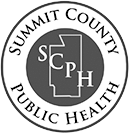News
Keep People and Pets Safe From Harmful Algal Blooms
Aug 27, 2019

Summit County - Cyanobacteria, often called blue-green algae, are commonly found in Ohio lakes, ponds, and slow-moving rivers. Although many species of blue-green algae do not produce toxins, some species of blue-green algae can cause Harmful Algal Blooms (HABs). Some of these HABs are visible as thick mats or scum on the surface of the water. These mats can vary in color, including bluish-green, bright green, or even red or maroon. You can’t tell if a bloom is harmful just by looking at it, and not all blooms are easy to see. Health hazards can be present even when you can’t see a harmful bloom. People or pets can get sick when they come in contact with contaminated water by:
- Doing recreational activities such as swimming, kayaking, fishing, or wading through water
- Breathing in tiny water droplets or mist that contains toxins from recreational activities or wind-blown sea spray
- Drinking contaminated water
- Eating contaminated seafood (fish or shellfish)
The Centers for Disease Control (CDC) recommends “When in Doubt, Stay Out.” When visiting lakes, rivers, or beaches, check the local water conditions. You can check the water conditions prior to your visit at http://publicapps.odh.ohio.gov/beachguardpublic/ and remember to observe all posted warning signs. If a health notice is posted or if you suspect a harmful bloom may be in the water, follow these recommendations:
- Don’t swim or come in direct contact with water that smells bad, looks discolored, or has scum on the surface
- Don’t let pets drink water, eat algae, or play or swim in it
- Stay out of the water if it has dead fish or other dead animals in or near it.
- Know the health risks of eating contaminated fish and shellfish and follow warnings
Illnesses and symptoms from harmful algal blooms can vary depending on how people and animals are exposed, how long the exposures last, and the toxins involved.
Symptoms can include:
- Skin, eye, nose or throat irritation
- Abdominal pain
- Headache
- Neurological symptoms
- Vomiting
- Diarrhea
If you do come into contact with the HAB-contaminated water, rinse off with clean, fresh water as soon as possible. Pets that have been swimming in an area with an algae bloom may ingest
significant amounts of toxins by licking their fur after leaving the water. Thoroughly rinse off your pets with clean, fresh water.
If you think you or your pet have become sick because of a harmful algal bloom, see your healthcare provider or veterinarian right away. Animals can get very sick quickly, so don’t delay
contacting your veterinarian.
For information, contact: Tonia Burford, Director of Environmental Health at tburford@schd.org or 330-802-0399.



